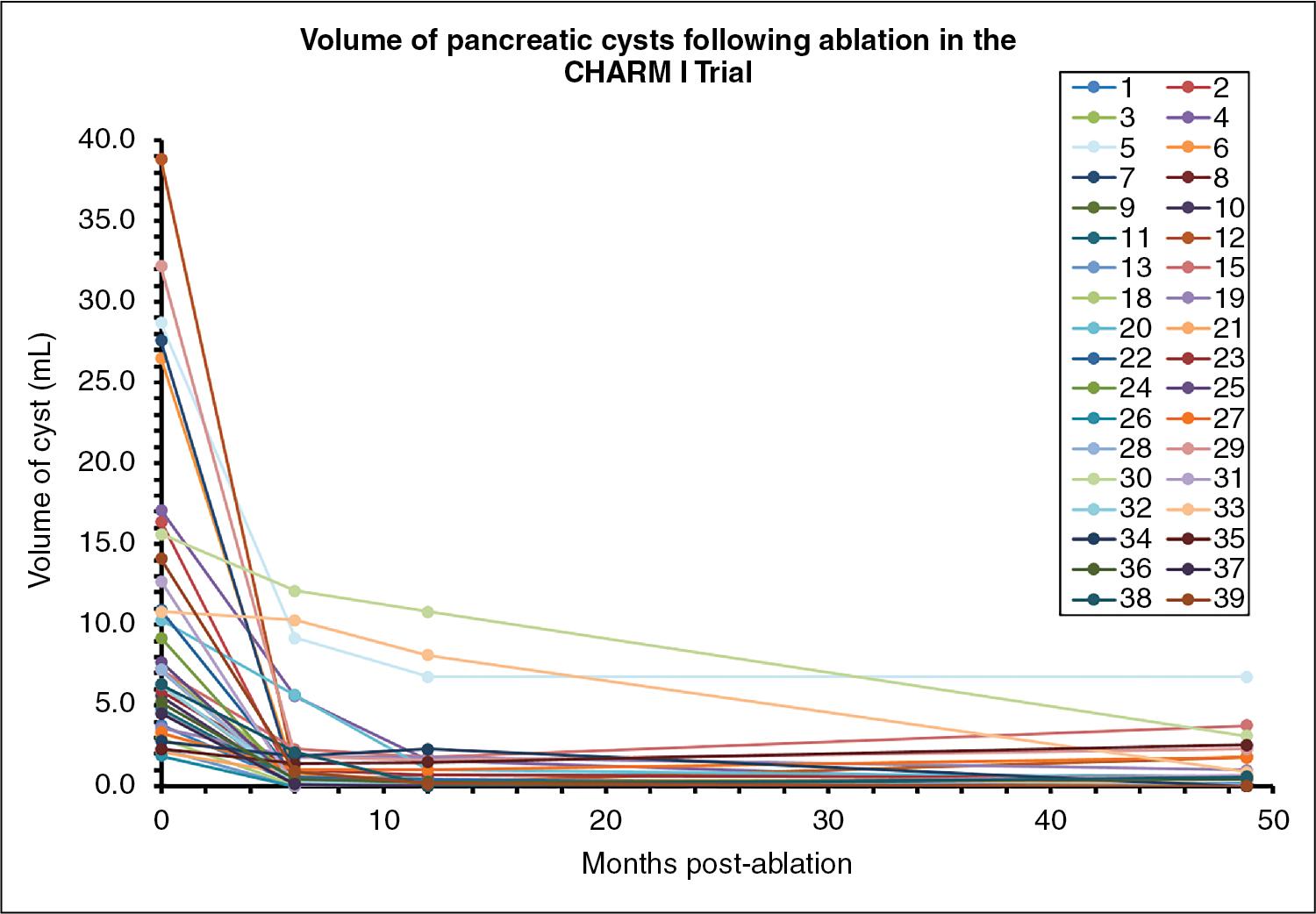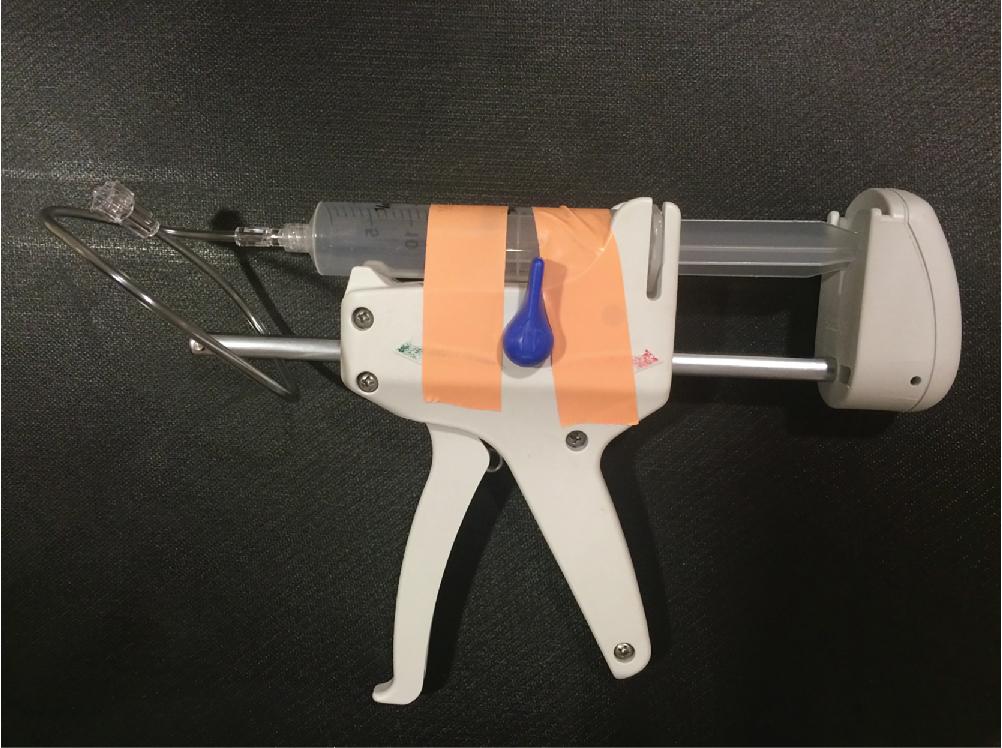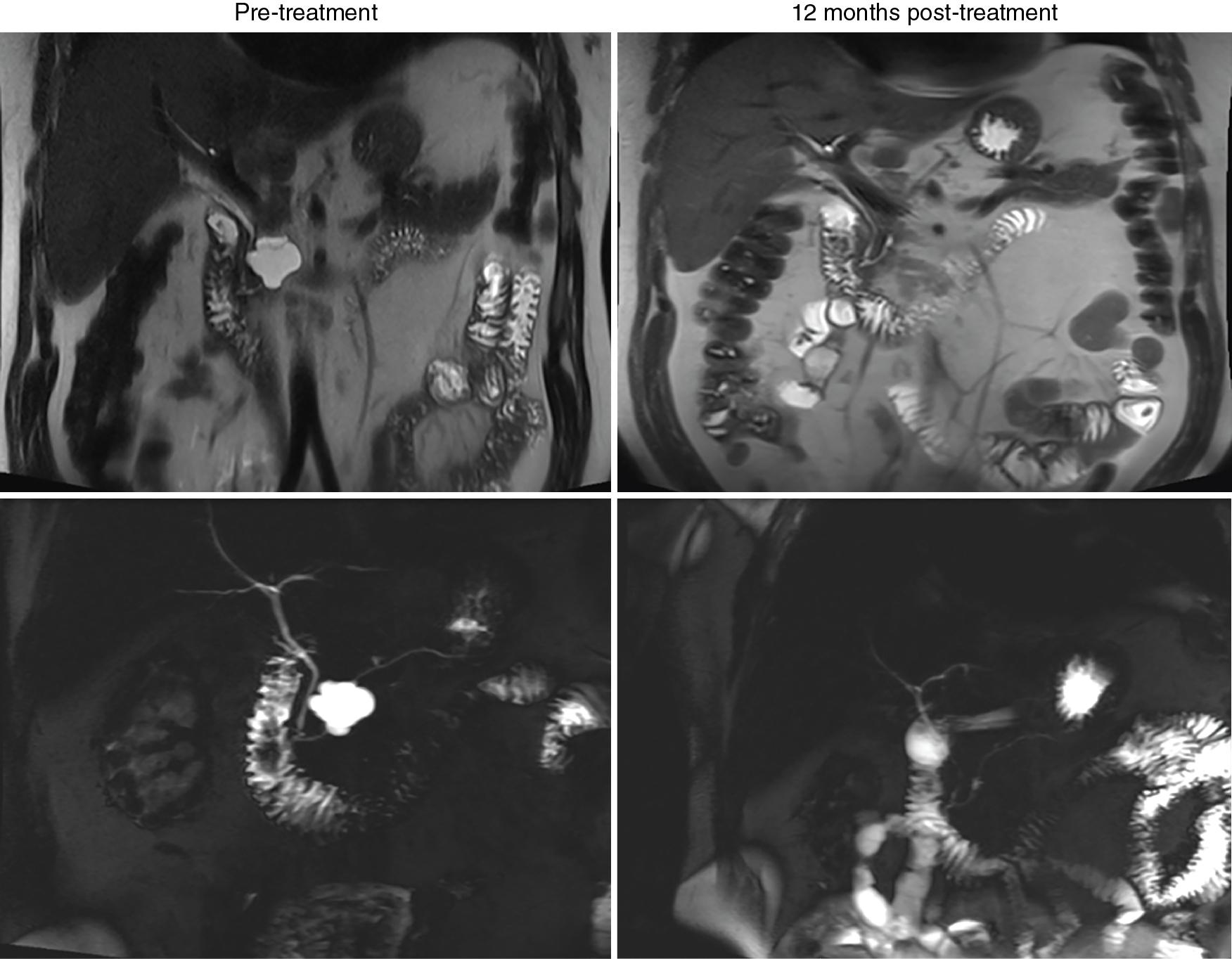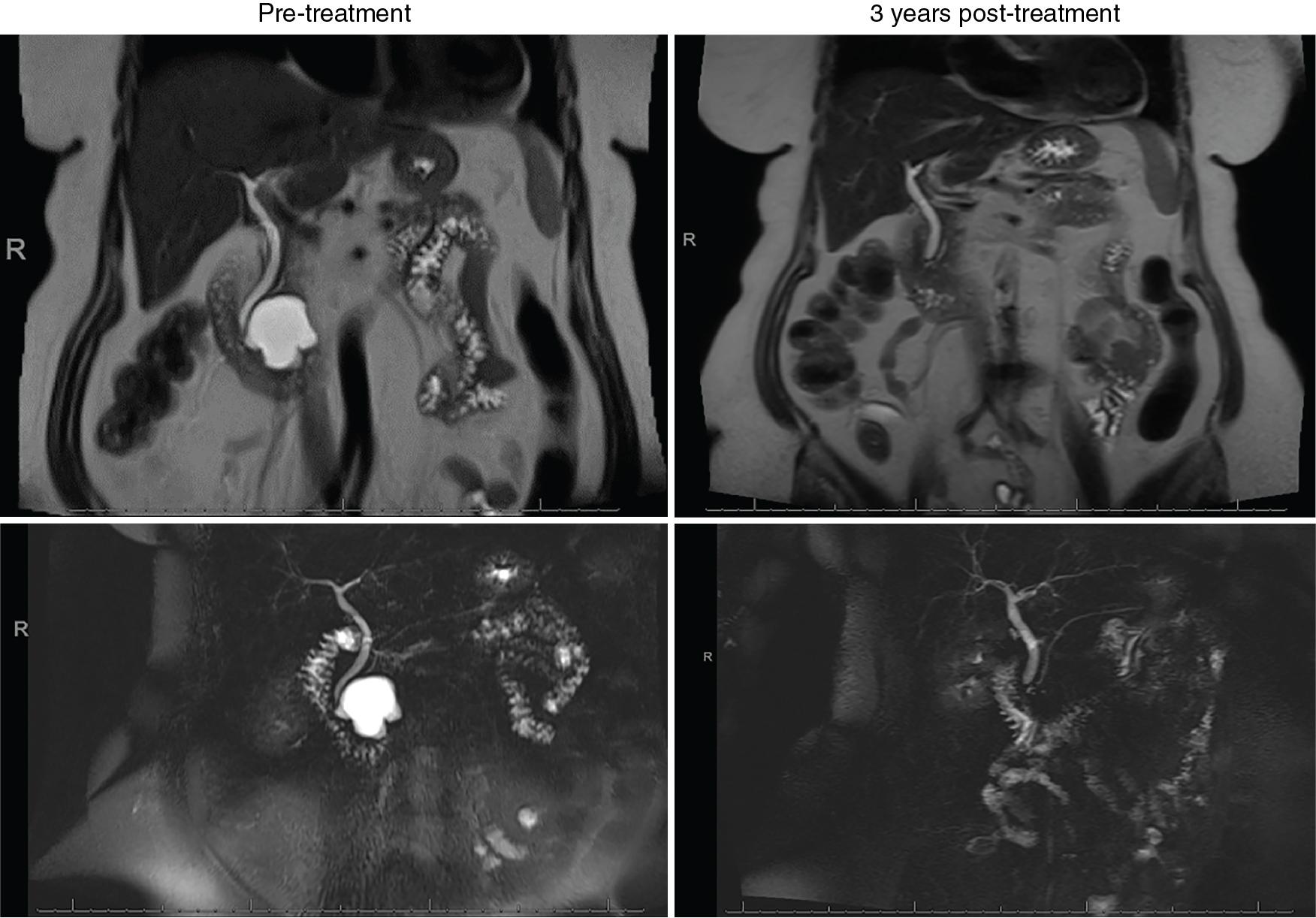Physical Address
304 North Cardinal St.
Dorchester Center, MA 02124
EUS-guided pancreatic chemoablation has emerged as an innovative, promising, and minimally invasive approach for the treatment of appropriately selected neoplastic type pancreatic cysts. When performed at expert centers, the treatment response appears durable in majority of patients at long-term follow-up.
EUS-RFA is an innovative minimally invasive treatment option for appropriately selected solid pancreatic mass lesions. The procedure is associated with a 10% to 15% adverse event rate and must be performed only by experts in a carefully selected patient subset.
While the premise of EUS-FNI adding value to multimodal treatment of pancreatic and other GI cancers remains appealing, a true clinical benefit has not been demonstrated yet. More studies are required to determine the true value of this clinical application.
Over 55,000 people will develop pancreatic cancer in the United States this year, with a 95% rate of fatality making it the fourth leading cause of cancer-associated mortality. , With a dismal survival rate under 10% (the lowest survival rate of any major cancer), it is projected to surpass colorectal cancer as the second leading cause of cancer-related mortality by 2030, unless there are breakthroughs in the prevention and early detection of this disease as we have seen in colon cancer. While the majority of pancreatic cancers are ductal adenocarcinomas, at least 20% of pancreatic cancers develop from mucinous-type pancreatic cyst precursor lesions, and this percentage may be underestimated. , Pancreatic cysts are typically discovered incidentally on cross-sectional imaging, with an overall prevalence of 2% increasing to 37% in individuals greater than 80 years old. This prevalence has grown dramatically over the last two decades due to an aging population and advances in imaging use and techniques, leading to a public health dilemma. Although certain types of pancreatic cysts carry little to no malignant potential, the majority are neoplastic and include mucinous cystic neoplasms (MCNs) and intraductal papillary mucinous neoplasms (IPMNs), which carry a significant potential for malignant transformation. While the natural history of mucinous cysts are variable, the overall risk of progression to pancreatic cancer is generally linked to their number of high-risk features. Most mucinous cysts are small and low risk; however, the overall risk of progression to malignancy from mucinous cysts (even without high-risk features) has been reported to range from 1% to 25%. It is difficult with current imaging techniques and cyst fluid analysis to predict which cysts will undergo malignant transformation and identification of a mucinous pancreatic cyst requires the clinician and patient to choose between indefinite radiographic surveillance or surgical resection, both of which have considerable limitations. Surveillance for malignancy carries significant economic and psychological burdens while waiting for a malignancy to develop. On the other hand, surgical resection possesses a substantial risk for serious adverse events (20% to 40%) and mortality (1% to 5%) and still requires postoperative surveillance. , An effective, less expensive, and safer approach to treating these cysts would be highly desirable.
Given the inherent risk for progression to malignancy, EUS-guided pancreatic chemoablation has emerged as an innovative, promising, and minimally invasive approach for the treatment of appropriately selected neoplastic-type pancreatic cysts. Initial investigations centered on EUS-guided cyst lavage with 80% to 99% dehydrated alcohol. This approach demonstrated feasibility but, as shown in Table 26.1 , offered limited efficacy with complete ablation rates of 9% to 35% and serious adverse event rates of 4% to 5% (generally pancreatitis). Overall, the clinical value of pancreatic cyst ablation with ethanol alone is unfavorable due to a suboptimal response with a significant adverse event rate, and its use as a single agent should be avoided. Oh et al. added the innovative step of infusing and leaving paclitaxel within the pancreatic cyst after ethanol lavage. Paclitaxel is a chemotherapeutic agent that arrests cellular microtubule assembly as well as G 2 mitotic-phase replication. The addition of paclitaxel infusion into the cyst has been shown in separate trials to increase complete ablation rates to 50% to 79%. This notable increase in efficacy compared to ethanol alone resulted in ethanol cyst lavage followed by reaspiration and then paclitaxel infusion becoming the preferred approach for pancreatic cyst ablation in the following years, and offered complete ablation rates similar to those seen with other ablative strategies in gastroenterology. Despite the increase in efficacy, a significant limitation in alcohol-based cyst chemoablation, with or without paclitaxel, is the associated serious adverse event rate of 3% to 10%, mainly due to pancreatitis, peritonitis, and venous thromboembolism. Importantly, the mechanism for these reported complications is believed to be due to the potent inflammatory and toxic effects of alcohol on the pancreatic parenchyma and/or neighboring vessels. Table 26.1 is a summary of the major published pancreatic cyst ablation trials and limited to those which used a prospective design.
| Author, Year | Study Type | Conditions (No. Patients) | Complete (CR) or Partial Resolution (PR) | Clinically Significant AEs |
|---|---|---|---|---|
| Studies That Used ETOH for Ablation | ||||
| Gan et al. (2005) | Prospective (pilot) | 5%–80% ETOH (25) |
|
0% |
| Dewitt et al. (2009) | Prospective RCT | 80% ETOH (25) SALINE (17) |
|
(ETOH) 24% (4% pancreatitis, 20% abdominal pain) (S)12% (abdominal pain) |
| Gomez et al. (2016) | Prospective (pilot) | 80% ETOH (23) |
|
8% (4% pancreatitis, 4% abdominal pain) |
| Studies That Used ETOH Lavage Followed by Paclitaxel Infusion | ||||
| Oh et al. (2008) | Prospective | 88 – 99% ETOH + paclitaxel (14) |
|
21% (7% pancreatitis, 14% abdominal pain) |
| Oh et al. (2009) | Prospective | 99% ETOH + paclitaxel (10) |
|
10% (abdominal pain) |
| Oh et al. (2011) | Prospective | 99% ETOH + paclitaxel (47) |
|
4% (2% pancreatitis, 2% abdominal pain) |
| Dewitt et al. (2014) | Prospective | 100% ETOH + paclitaxel (22) |
|
23% (10% pancreatitis, 13% abdominal pain) |
| Studies That Used ETOH Lavage Compared With Alcohol-Free Lavage Followed by Paclitaxel + Gemcitabine Infusion | ||||
| Moyer et al. (2016) | Prospective (pilot) | 80% ETOH then paclitaxel + gemcitabine (4) Saline then paclitaxel + gemcitabine (6) |
|
|
| Moyer et al. (2017) | Prospective RCT | 80% ETOH then paclitaxel + gemcitabine (18) Saline then paclitaxel + gemcitabine (21) |
|
|
A significant advancement in procedural safety occurred with the ChARM trial published in 2017. This single-center, randomized, prospective, double-blind trial of 46 patients with mucinous cysts randomly assigned patients to either pancreatic cyst lavage with 80% alcohol or normal saline (alcohol-free group). The lavage agent was then fully aspirated and both groups had their cysts then infused with an admixture of paclitaxel + gemcitabine. Primary outcomes were the rates of complete ablation at 12 months and rates of serious and minor adverse events within 30 days of the procedure. At 12 months, 67% of patients who underwent alcohol-free EUS-guided pancreatic cyst chemoablation enjoyed complete ablation compared to 61% of patients in the control group. Serious and minor adverse events occurred in 6% and 22% of the alcohol-based group, and in 0% of the alcohol-free group ( P = .01). While limited by a relatively small sample size, the overall conclusions of this RCT were that alcohol was not required for effective EUS-guided pancreatic cyst ablation, and more importantly, when alcohol is removed from the ablation process, there is a significant reduction in associated adverse events. This trial has led to the multicenter, randomized, ChARM II clinical trial funded by the NIH with expected completion in 2024. This much larger clinical trial has incorporated several technical improvements to the procedure.
When discussing adverse event rates with EUS-guided pancreatic cyst ablation, one should note that there is a background risk of adverse events with simple EUS FNA that should acknowledged. In a systematic review of almost 1000 patients who underwent diagnostic EUS-FNA, the overall complication rate was 2.75% with the most common complication being pancreatitis occurring in 1.1% of patients followed by pain (0.77%), bleeding (0.33%), fever (0.33%), and infection (0.22%), with pancreatitis rarely being severe.
One area of uncertainty had been a lack of evidence of the long-term durability of pancreatic cyst chemoablation. Three trials to date have now addressed this with DeWitt et al. demonstrating long-term durability of pancreatic cyst ablation over 2 years, including elimination of detectable KRAS mutations. In a more recent, large, prospective, follow-up study of 164 patients who underwent EUS-guided chemoablation with alcohol followed by paclitaxel, Choi et al. demonstrated that when patients achieved complete EUS-guided chemoablation initially, 98% remained in complete ablation at 6 years, demonstrating excellent durable response following ablative therapy. However, a noted limitation of this study was that this clinical trial included all cysts types (neoplastic as well as others). In 2021, the long-term follow-up of the ChARM trial was performed to assess the durability of treatment response following EUS-guided chemoablation of exclusively mucinous lesions ( Fig. 26.1 ). In this long-term follow-up, a single radiologist read the baseline, 12-month, and long-term follow-up images for each of the included patients. As in all trials, cysts were measured in at least two dimensions with the cyst volume calculated using the formula 4/3 × π × r 3 (where r the cyst radius) and treatment response defined according to percentage reduction in cyst volume from the baseline as follows: complete response is 95% or greater reduction in cyst volume; partial response is 94% to 75% reduction; and nonresponse is <75% reduction. Of the 39 treated patients, 36 were included in the long-term analysis, which was a mean of 36 months. Of the 23 patients who achieved complete response in initial assessment, 87% sustained those results at their long-term follow-up. The three patients who did not largely maintained their treatment response of 91% to 93% reduction in cyst volume. In addition, several protracted treatment responses were noted with four cysts originally classified as partial responders found to have completely resolved at the latest follow-up, and two cysts initially classified as nonresponders achieved partial response. Overall, this trial showed that EUS-guided chemoablation with paclitaxel and gemcitabine is durable, with 87% of complete responders maintaining their complete response long-term (beyond 36 months), with the possibility of protracted treatment effects in 31% of patients who did not achieve complete response initially continuing toward resolution. In addition, the reduction in cyst size allowed patients to be radiographically surveyed less frequently over long-term follow-up (typically with annual-interval MRI).

In order to add significant clinical value, EUS-guided pancreatic cyst chemoablation should not be performed on certain high-risk lesions that are likely to harbor malignancy and are unlikely to completely respond and thus be better treated by surgical resection. Alternatively, it should also be avoided in small, low-risk cysts with little chance of malignant progression, as these are more appropriate for routine surveillance as per standard guidelines. , Ablative strategies should be focused on pancreatic cystic tumors that are technically amendable to cyst ablation and do not yet show overt signs of malignancy. Only pancreatic cysts with a likelihood of progressing to malignancy are currently candidates for ablation. For that reason, the first step is to use clinical, radiographic, cytological, and chemical analysis by EUS-FNA to diagnosis and risk-stratify a mucinous cyst. Admittedly there remains a level of uncertainty with the accurate diagnosis and risk stratification of pancreatic cysts in 2021, and most cysts are less than 2 cm and low risk and best managed by routine surveillance. In a recent large study evaluating the long-term risk of pancreatic malignancy in patients with mucinous pancreatic cysts, 577 patients with presumed side-branch IPMNs were followed for the development of malignancy over a 5-year period. The overall rate of malignancy was 5.5%; however, of pancreatic cysts 1.5 cm or smaller, the overall risk of malignant transformation was 0.9%, demonstrating a very low risk for progression to malignancy in pancreatic cysts less than 1.5 cm without other high-risk features. In addition, it is technically challenging to perform EUS-guided pancreatic cyst chemoablation on cysts less than 2 cm, as there is 0.8 cc of volume within the FNA needle itself, which can prohibit meaningful exchange of cyst fluid with chemotherapeutic agent in small cysts. Consequently, the appropriate size for consideration of ablation is generally felt to be 2 to 6 cm.
Cyst morphology is also an important consideration, as multiseptate cysts are technically challenging, since infusion of ablation agent into each loculation of the cyst is required. In particular, cysts that appear as a “cluster of grapes” are resistant to effective ablation. Most trials to date have favored unilocular or oligolocular mucinous cysts with less than 4 to 5 discreet chambers for this reason. Of note, although cysts can appear multiseptate on MRI/MRCP, at EUS-FNA the cyst may completely collapse, indicating communication between these individual compartments, thus suggesting that they are technically amenable to complete ablation. On reviewing previous clinical trials and our own experience, the recommended ideal indications and contraindications for pancreatic cyst ablation can be summarized as follows.
Patients with previously identified pancreatic cysts from 2 to 6 cm in diameter that are consistent with mucinous-type cysts as per guidelines including indeterminate-type cysts.
Contraindications:
Pregnancy
Similar to colonoscopy/polypectomy, the patient should have a reasonable 3–5 year life expectancy in order to benefit from treating a precancerous lesion
Inability to safely undergo a 30–60 min procedure with monitored anesthesia care.
Signs of malignancy or cytology suspicious for malignancy
Lesions that are consistent with a benign cyst by clinical, radiographic, cytologic, and chemical analysis (pseudocyst, serous cystadenoma, lymphangioma, duplication cyst, etc.).
Relative contraindications:
Cysts with the following high-risk features:
Main pancreatic duct dilation ≥5 mm
Epithelial-type mural nodules >3–5 mm
Pathologically thick walls or septations >2 mm
Signs of common bile duct or pancreatic duct obstruction, pathologic lymphadenopathy associated with the cyst, recent pancreatitis, pancreatic duct stricture associated with tail atrophy
Septated cysts with >4–5 discrete individual compartments
Irreversible coagulopathy, neutropenia, or thrombocytopenia with platelets <30,000
General recommendations are that patients considered for EUS-guided pancreatic cyst chemoablation undergo a full evaluation in the outpatient clinic setting where the cyst’s clinical, radiographic, and endoscopic characteristics can be reviewed and explained to the patient. The natural history of these lesions, areas of uncertainty, and conventional options of surveillance and or surgical resection should be reviewed with the patient as appropriate and a genuine informed consent obtained. , As recommended in a published international white paper on pancreatic cyst ablation, it is recommended that these procedures be performed by an interventional endoscopist with formal training and credentialing in EUS and familiar with interventional EUS procedures. It is also our recommendation that these procedures be performed only at high-volume centers in a multidisciplinary environment including the availability and expertise of surgical oncology.
A standardized pathway for ordering the chemoablation agent from your institution’s chemopharmacy and delivery to your endoscopy unit must be established. Typically, most large referral centers will have an interventional radiology group that perform similar procedures and are a good source of information in how to order and manage chemoablation agents for that institution’s interventional endoscopy group. After the procedure is scheduled, a standardized order form (see Appendix 1) can be sent to the pharmacy with the patient metrics and the amount of chemoablation admixture ordered to be available on the date of the procedure. As described previously, , it is our practice to use a multi-agent chemotherapy infusion cocktail created by mixing 6 mg/mL paclitaxel 1:1 with 38 mg/mL gemcitabine, resulting in a working solution of 3 mg/mL paclitaxel and 19 mg/mL gemcitabine. The amount of chemotherapy infusion required to fill a 5-cm cyst would be approximately 65 mL; however, for safety purposes, a maximum volume of 25 mL of this chemotherapeutic cocktail (75 mg paclitaxel and 475 mg gemcitabine) can be administered to a patient, after which normal saline can be infused to restore the original cyst volume (if necessary) for an even distribution of the admixture within the cyst. This maximum dose is well under the maximum doses described for these drugs when used for intravenous or intraperitoneal therapy, either alone or in combination. In addition, paclitaxel blood levels checked during the ChARM cyst ablation trial showed that drug concentrations stay within the cystic tumor (negative blood levels post ablation). The chemoablation-filled infusion syringe + connector tubing should be picked up the morning of the procedure and brought to the endoscopy unit in an appropriate bag and handled as per your institution’s policies. The nursing aspects of the procedure can be reviewed in the video that accompanies this book chapter.
Preparation for ablation is similar to standard EUS-FNA; however, the anesthesiologist should be aware that during the period of the actual ablation, the patient should be relatively still, and if excessive coughing, retching, or disruptive respiratory movements are felt to be likely, general anesthesia with paralysis should be considered. The initial EUS examination is carried out in standard fashion, and it is important to fully inspect the entire pancreas (not just the cyst), particularly in patients with IPMNs who can develop concomitant pancreatic adenocarcinoma (PDAC) in regions separate from the cyst of interest. , The EUS-FNA needle is then introduced into the center of the target cyst, carefully aspirating nearly the entire cyst fluid contents. It is our practice to use a 22-gauge FNA needle for target cysts measuring 2 to 3 cm in diameter or in technically challenging locations such as the uncinate region. A 19-gauge needle is used for cysts greater than 3 cm in diameter or previously shown to have highly viscous cyst fluid. If a lavage agent is used, the cyst will then be alternatively filled and aspirated with ethanol for 3 to 5 minutes using an amount equal to the mucinous fluid originally aspirated. A small rim of fluid is left around the needle tip at all times to avoid damage to the cyst wall or introducing the needle tip into the surrounding parenchyma. It is our practice to use a completely alcohol-free approach, which also eliminates the need for the lavage step. Instead, after initial cyst aspiration, the chemoablation agent is simply infused into the cyst (see Fig. 26.2 ) using an amount equal to the volume of mucinous fluid originally aspirated, reconstituting the cyst to its original size and dimension. As paclitaxel is notably viscous, infusion of the chemoablation admixture requires higher pressures, and so an infusion apparatus using a 30-cc high-pressure polycarbonate medication syringe with Luer Lock fitting and high-pressure connector tubing (DYNJSYRPC30P and DYNJTBGHP10F; Medline Inc.) securely taped to a high-pressure gun (Alliance II; Boston Scientific Inc.) or other infusion device is typically used (see Fig. 26.3 ). It is important to assure that all connections are secure and that there is no air in the connector tubing prior to infusion of the admixture. The need for antibiotics during this procedure is unclear, but we recommend following current ASGE guidelines for EUS-FNA regarding this issue. It is our recommendation to establish a dedicated EUS-guided chemoablation team in your endoscopy unit in order to improve efficiency and avoid mistakes. In addition, we recommend that these patients be observed for additional time postoperatively. All equipment that came in direct contact with the chemotherapy agent must be disposed in appropriate containers as per your institution’s policy. For a technical demonstration of the cyst ablation technique, please see the video accompanying this book chapter ( ![]() ).
).


It has been previously shown that multiple serial ablation treatments are more effective than a single ablation session for pancreatic cystic tumors (similar to treatment of dysplastic Barrett’s esophagus), and it is our approach to utilize two to three alcohol-free gemcitabine-paclitaxel treatments at 3-month intervals. Residual cystic tumor at the second and third evaluations measuring greater 1.5 cm are retreated as appropriate. This is followed by clinic evaluation and cross-sectional imaging at 6 and 12 months with enhanced MRI (or computed tomography if MRI is contraindicated) (see Figs. 26.4 and 26.5 ) for before and after images. For lower-risk cysts, a 12-month postablation follow-up MRI and clinic visit may be sufficient. Treatment response is determined by measuring cyst volume using the formula 4/3 × π × r 3 (where r the cyst radius) and defined as complete (≥95% reduction of cyst volume), partial (94% to 75% reduction), or nonresponse (less 75% reduction) at 1-year follow-up. It is our practice for patients to then reenter a surveillance program using the posttreatment measurements and characteristics of the pancreatic cyst per standard guidelines. This typically allows a reduction in radiographic surveillance intervals and is typically done on an annual basis unless otherwise indicated. We recommend that this procedure be offered as part of an ongoing quality review process in order to monitor outcomes and identify areas of concern or in need of modification and improvement.


EUS-guided pancreatic cyst chemoablation is a promising and innovative technique for treating mucinous-type pancreatic cysts; however, as reviewed in this chapter, patient selection is key, and a full discussion with the patient of all their treatment options, including surveillance and surgical consultation, is important. Furthermore, this procedure should be carried out in a multidisciplinary environment in a high-volume center with appropriate expertise in gastroenterology, surgical oncology, radiology, and pathology. Although training requirments for this procedure have not been elucidated, we recommend that specialized centers interested in this technique undergo orientation and training in the technique by an expert experienced in this technique and process. It should be acknowledged that there are currently no FDA-approved devices for this procedure and that this approach is not yet endorsed by conventional guidelines on pancreatic cyst management. It is also important to note that ablation does not completely eliminate a patient’s risk of developing PDAC. Two large retrospective multicenter studies in Japan demonstrated that patients under long-term surveillance for IPMN, some of which had been treated surgically, carried a 2% to 4% risk of developing a metachronous pancreatic malignancy in the remaining pancreas over subsequent years. , As a result, whether a surgical, ablative, or a surveillance strategy is employed, current guidelines suggest long-term surveillance will be required until the age and/or comorbidities of the patient makes further surveillance unwarranted. An exception to this would be for surgically resected mucinous cystic neoplasms (MCN variant), which do not require long-term surveillance.
Become a Clinical Tree membership for Full access and enjoy Unlimited articles
If you are a member. Log in here